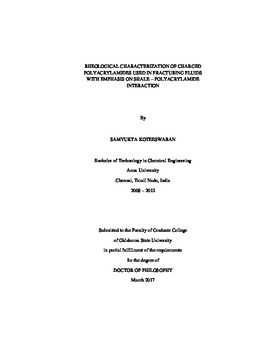| dc.contributor.advisor | Clark, Peter E. | |
| dc.contributor.author | Koteeswaran, Samyukta | |
| dc.date.accessioned | 2018-03-13T18:15:58Z | |
| dc.date.available | 2018-03-13T18:15:58Z | |
| dc.date.issued | 2017-03 | |
| dc.identifier.uri | https://hdl.handle.net/11244/54556 | |
| dc.description.abstract | Interaction of polymer containing injected fluids with shale is a widely studied phenomenon, but much is still unknown about the interaction of charged polyacrylamides such as anionic and cationic polyacrylamides with shale. The nature of interaction of charged polyacrylamides with shale is not well understood, especially from the perspective of assessing the potential for polyacrylamides to cause formation damage. Zeta potential and rheological measurements were made for Chattanooga and Pride Mountain shales suspended in polyacrylamide solutions with and without inorganic salts and tetramethyl ammonium chloride (TMAC). The change in zeta potential and viscosity with time is recorded. The magnitude of decrease in the absolute value of zeta potential with time is indicative of adsorption of polymer on the surface of shale and serves as a measure of the extent of polymer interaction with shale. The salts that were used in this study are potassium chloride (KCl), sodium chloride (NaCl). This study quantifies the interaction of anionic and cationic polyacrylamide with different shales from North American region. From the experimental results, it was determined that the polyacrylamides interact strongly with shale particularly the cationic polyacrylamide. The objective of this study was to determine the extent of interaction of anionic and cationic polyacrylamide with each shale sample in the presence of additives such as salts. Additionally, this work presents qualitative techniques for evaluating shale-fluid interaction. A simple desktop test method, such as immersion testing, can help production engineers choose the appropriate shale inhibitors such as salt, Tetramethyl ammonium chloride and polymers that can effectively reduce the impact of oilfield fluids invading shale and causing it to swell or disperse. The swelling tendency of shale is highly dependent on clay mineralogy and other properties, such as porosity and permeability. A series of immersions tests was performed to study the combined and isolated effects of salt, TMAC, and polyacrylamide on preventing shale from becoming unstable. The merit of each fluid system in shale inhibition is probed for Woodford, Chattanooga and Pride Mountain shale. Rheology of bentonite slurries are studied with different salts and TMAC to probe their efficiency in preventing the swelling of bentonite clay. | |
| dc.format | application/pdf | |
| dc.language | en_US | |
| dc.rights | Copyright is held by the author who has granted the Oklahoma State University Library the non-exclusive right to share this material in its institutional repository. Contact Digital Library Services at lib-dls@okstate.edu or 405-744-9161 for the permission policy on the use, reproduction or distribution of this material. | |
| dc.title | Rheological characterization of charged polyacrylamides used in fracturing fluids with emphasis on shale-polyacrylamide interaction | |
| dc.contributor.committeeMember | Pashin, Jack C. | |
| dc.contributor.committeeMember | Aichele, Clint P. | |
| dc.contributor.committeeMember | Hareland, Geir | |
| osu.filename | Koteeswaran_okstate_0664D_15047.pdf | |
| osu.accesstype | Open Access | |
| dc.type.genre | Dissertation | |
| dc.type.material | Text | |
| thesis.degree.discipline | Chemical Engineering | |
| thesis.degree.grantor | Oklahoma State University | |
